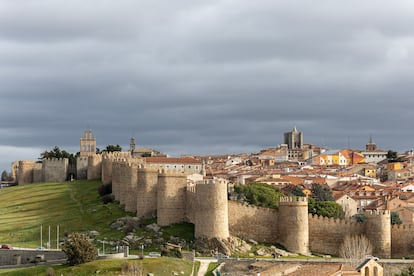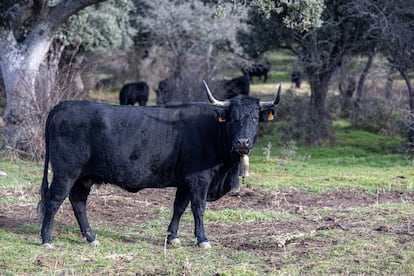To the race and traumatic way they left the vetones the Castro of Miranda’s table, 22 kilometers from Ávila. A fibula (a brooch) and bronze rings found last November prove that they went in a hurry without taking the most precious, and never returned, nor the settlement was looted. It was the second century BC. C., were the Celtiberian wars. The archaeologist Juan Pablo López and his team were the ones who found the jewels, but a neighbor of Chamartín (the town next door) or a client of the Avila Parador who came with the wall and Santa Teresa in mind in mind in mind in mind in mind could participate in the excavation. He returns with a new hobby. The works are community, says López. The technicians protect the projects, but involve everyone who shows a little interest: “To call me whoever wants, that I bring them to this great protohistoric city,” invites the archaeologist in the Castro, in front of a field of stones fuzzy , a defensive element to stop the cavalry. “What we do is ethnoarcheology. We seek people to connect emotionally with the landscape, ”he adds without mysticism, that is the thing of the saint.
Inside the hostel
Anterior
Following
López, archaeologist but also a hotelier, knows him Lucía Sánchez, tourist guide for 25 years in Ávila, and Víctor Teodosio, the director of the hostel – the longest worker of this public company founded in 1928 (“More than 50 years,” he says without wanting to specify with a mixture of shyness and pride) -. Ávila is a town. That is, it is a capital with 58,111 inhabitants, but everyone is known. And the hostel customers are known at all. Everything is close, everything is walks and stops in the first Gothic cathedral in Spain, in front of the size of Santa Teresa held in 1653 by the Baroque artist Gregorio Fernández or in the twenty palates that are inside the wall.
Outside the enclosure, the place where you have to stop with the car as soon as you arrive is the humiller of the four posts on the Adaja river. Nothing is being discovered here, but everything changes if the visit begins from this monument to Santa Teresa that allows you to realize the immensity of the wall, of the splendor of the city, of what will later go on foot. Imagine to take the subway from Heathrow airport, in London, to Westminster without going through the hotel to see the Big Ben. Well, but in Ávila, 110 kilometers from Salamanca, where the Route de la Plata that connects Gijón with Seville.

Theodosius says that customers are attracted to the monumentality of the city, “because it is a historical site,” summarizes this legendary director born in Oropesa (Toledo). “Also for gastronomy, by the chuleton of Ávila,” summarizes in a lounge with fireplace, carpet, upholstered chairs, sofas and two earrings (this is hostels after all, a home). That has been the plan in Ávila for a long time: to be hungry while visiting the Romanesque Basilica of San Vicente or the wall is traveled above and below and then ask for some beans of El Barco, grilled meat and yolks of Santa Teresa . But there is much more and more differential – one does not want to get to work on Monday and tell what they had already told him.
Activities for all in a natural environment
Cultural visits, sustainable tourism, dynamization of the area …
How to get the most out of the area where the Avila Parador is located
To start, Ávila as a city of the Renaissance represented in its palaces, Sánchez insists, the guide. It is worth the courtyard of the Military Archive of Ávila (free), access the Palacio de los Superunda to see their adinteladged courtyard and two large portraits of sorolla (5 euros) or visit the Royal Monastery of Santo Tomás (4 euros), which, which It is a little further: “What is not attached to the wall tourists do not see it,” Sánchez launches. Ávila is not Segovia or Toledo, recalls the guide, which still states that the capital with greater altitude (1,131 meters) in Spain has become fashionable. “Tourism grows but the essence is maintained,” he summarizes. The face washing, the prohibition that the buildings did not exceed the height of the wall and the harmony of colors of the facades was carried out several decades ago. Keep looking.
Miriam, José Manuel and Ana María recommend

The Soto is a 40 -hectare park that is located half an hour walking from the hostel. It is crossed by the Adaja, the main river of Ávila. It walks between ashosnos, on several paths that intersect. There are those who are going to do sports, for a walk. It is a large green surface to be in the city.
Miriam Grande
Waitress 14 years in Paradores

In the Valley of Iruelas there is a swamp, that of Burguillo, where people are going to fish and spend the day. There are several marked paths to make routes of one or four hours. It is Sierra, slopes are uploaded. When you have been very good for a long time. I really like to go with the children, there is a picnic.
José Manuel Pedrero
Maintenance Head 23 years in Paradores

The daughter of God is a town that is 28 kilometers from the hostel. On one side of the road, when you arrive, there is a dam to leave the car. It is a mountain area to walk, but quite flat, it is not necessary to be an expert; I go with my little children. There is water everywhere.
Ana María López
Cook 14 years in Paradores
Extramuros, the city grows, and it is also the Castro of Miranda’s table. From the hand of López changes the story, but it can also be visited for free. If the field of stones is left to the right, it is mounted on one of the doors of the Castro. “They created corridors to focus the attacks,” describes López, a graduate in History from the University of Salamanca. The enemy was waiting for archers with arrows and sneakers with stones.

The settlement is located in the Sierra de Ávila. It is one of those landscapes to which a photo does not do justice, it is not even in TripAdvisor. But it has magic, it’s field, it’s Dehesa, it’s nature, it’s wild, it’s unknown. Modern constructions are not divided. “The territory retains purity. There is no visual noise, ”he says. With a good explanation, you immerse yourself in the past. There is barely a very at the beginning and only a small catwalk. It is not recharged from the elements of deposits oriented to a large flow of visitors. What there are are stones that constitute a wall, a necropolis or a carved calendar. They are the ones that were already then, of course. “We study the language of the stones. This town did not leave written texts, ”says López, 46. When the Cultural Association Abulaga arrives, directed by this enthusiastic archaeologist, the excavations will resume. They will ask for help from a neighbor to move the land or stones with their machinery, and they will speak and ask, just like peasants in the area. “They are the guarantors of this landscape and a well -understood tradition. You have to register the information and evolve, ”says López.
The cows, in its place
Through these same fields the native cows of the Avileña-Negras Iberian, native to the Sierra de Ávila and that of Gredos. With this animal, López is also dealing with. They are analyzing from remains found the evolution of this bovine of the peninsular center. 660 farmers, of which 248 remain active, are associated with the protected geographical indication (PGI) Ávila meat. These animals worked in the field, in agriculture. The peasants had two cows and a piece of land, recalls José Juan Vila, the president of the IGP. Since the middle of the last century he went to livestock.
Vila has 150 cattle in the Sierra de Ávila. “It’s a rustic cow, it doesn’t need much attention. Eat what is on the mountain, as if it were a goat, ”he says in front of a 900 kilos bull. Each cow gives a calf a year. When the animal has between 12 and 16 months and weighs about 350 kilos, after having pasted in the pasture, it is destined for meat. The farmer acknowledges that veganism is growing and hunting is getting worse, but not fighting those trends, but focuses on defending the meat of the Avileña with respect to others that have become fashionable in recent years: La Angus or Wagyu. “Ours in quality-precious is not comparable,” he says.

The plan to eat grilled meat in Ávila is so institutionalized, that the city is plagued by posters in which it is announced. “We fight against fraud,” says Vila to refer to those establishments that serve meat from other races despite selling it like Ávila. The one that serves in the hostel is authentic, a vitola with the IGP logo attests to it when it reaches the table, then each one checks it in their mouth.
Castilla y León, in 15 hostels
Credits:
Drafting and script: Mariano godson
Editorial Coordination: Francis Pachá
Photograph: Pablo Monge
Development: Rodolfo Eyes
Design: Juan Sánchez
Design Coordination: Adolfo Domenech





